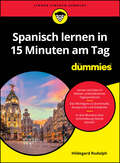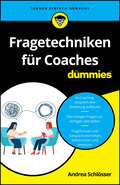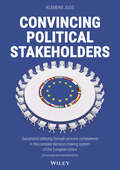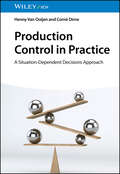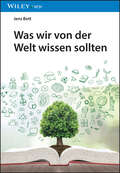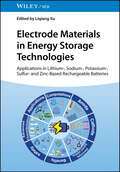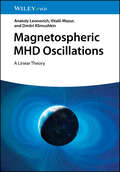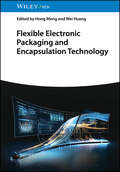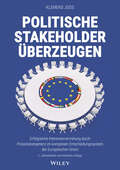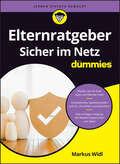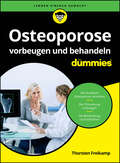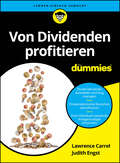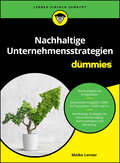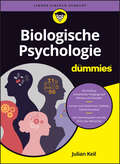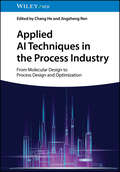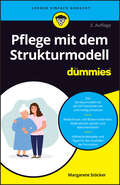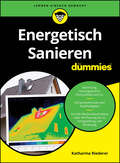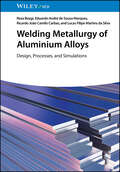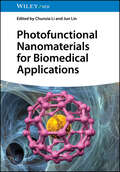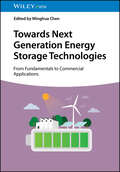- Table View
- List View
Spanisch lernen in 15 Minuten am Tag für Dummies (Für Dummies)
by Hildegard RudolphNur ein Viertelstündchen Spanisch am Tag Sie wollen Spanisch lernen, ohne stundenlang Vokabeln und Grammatik zu pauken? Dann ist dieses Buch genau das Richtige für Sie! In auf 15 Minuten pro Tag begrenzten Lektionen bringt es Ihnen die spanische Sprache näher. So erfahren Sie im Handumdrehen alles Wichtige über Grammatik und Aussprache und erweitern Ihren Wortschatz. Mit regelmäßigen Wiederholungsfragen können Sie Ihr Wissen testen. Zum Download verfügbares Audiomaterial rundet die Lektionen ab. So werden Sie, wenn Sie nach drei Monaten das Buch durchgearbeitet haben, in der Lage sein, sich auf Spanisch zu verständigen. Sie erfahren Wie Sie in jeder Situation die richtigen Worte finden Mit welchen Redewendungen Sie brillieren Welche Wörter Sie nicht verwechseln sollten Wie Sie das Spanische richtig aussprechen
Fragetechniken für Coaches für Dummies (Für Dummies)
by Andrea SchlösserDie Kunst des Fragens – Ihr Schlüssel zu erfolgreichen Coachings Fragen sind das Herzstück jedes Coaching-Prozesses. Sie regen Klienten zum Nachdenken an, eröffnen neue Perspektiven und fördern nachhaltige Veränderungen. Doch welche Fragen sind wann am sinnvollsten? Andrea Schlösser zeigt Ihnen, wie Sie einen vertrauensvollen Gesprächsrahmen schaffen, in dem sich Ihre Klienten öffnen und echte Erkenntnisse gewinnen. Sie führt Sie durch die Vielfalt der Frageformen und erklärt, wie Sie diese gezielt im Coaching-Gespräch einsetzen. Freuen Sie sich auf praktische Tipps und wertvolle Formulierungshilfen. Sie erfahren Was erfolgreiche Gespräche brauchen Welche Frageformen es gibt Wie Sie richtig gute Fragen stellen Wie Sie schwierige Gesprächssituationen souverän meistern
Convincing Political Stakeholders: Successful Lobbying Through Process Competence in the Complex Decision-making System of the European Union
by Klemens JoosIn the new edition of his standard work, the founder of one of the most successful lobbying companies in the European Union (EU), Prof. Klemens Joos, bundles experience acquired over more than three decades to form a scientific theory on governmental relations. It focusses on the insight that, in view of the increasingly complex decision-making structures of the EU, the most precise possible knowledge of decision-makers and decision-making processes is at least equally as important to success as the content aspects of interest representation. In a new chapter, the author sets out the formula for science-based interest representation developed by him from his practical experience. With the Treaty of Lisbon, which entered into force on 1 December 2009, the EU de facto became a state territory stretching from Portugal to Finland and from Ireland to Cyprus. The European Parliament became an equal-status decision-maker alongside the Council of the European Union (Council). The previous co-decision procedure was elevated to become the standard procedure ("ordinary legislative procedure"). The so-called qualified majority (55 percent of the EU member states which simultaneously represent at least 65 percent of the EU population) was introduced for all important areas in the Council. As a result, the outcome of decision-making processes has become largely incalculable for the actors on the "European Union stage" - the EU member states, EU regions, companies, associations and organisations. The second edition includes a new chapter, in which Prof. Klemens Joos makes the variables of successful interest representation even more tangible on the basis of his scientific formula: at the latest since the Treaty of Lisbon, the basic prerequisite for successful interest representation in the EU involves the continuous and close intermeshing of the affected party's content competence (of the four "classic instruments" of interest representation: corporate representative offices, associations, public affairs agencies, law firms) with process structure competence (i.e. the EU-wide maintenance of the required spatial, personnel and organisational capacities as well as strong networks across institutions, political groups and member states) on the part of an independent intermediary. The likelihood of success can be increased exponentially if success is achieved, firstly, in committing to the concern of an affected party through a change of perspective such that the positive effects on the common good are shifted into the foreground for the decision-makers in the EU (perspective change competence) and, secondly, in successfully integrating the concern into the crucial decision-making processes at the political level and continuously supporting it (process support competence). Guest authors: This work includes guest contributions from Prof. Christian Blümelhuber (Berlin University of the Arts), Prof. Anton Meyer (formerly LMU Munich), Prof. Armin Nassehi (LMU Munich) and Prof. Franz Waldenberger (Director of the German Institute of Japanese Studies, Tokyo) as well as a foreword by Prof. Gunther Friedl (Dean of the TUM School of Management) and a preface by Prof. Thomas F. Hofmann (President of TU Munich).
Production Control in Practice: A Situation-Dependent Decisions Approach
by Henny Van Ooijen Corné DirneProduction Control in Practice Practice-oriented coverage of production planning and control processes for goods and services, written for any industry Production Control in Practice explores the operational control of production and inventory processes in organizations across industries, covering both tangible and intangible products and offering viable, efficient solutions to characteristic production control problems, such as what goods to produce when and how. A number of examples/stylized applications are included to help readers understand and apply the discussed concepts and theories to their own organizations. This book distinguishes between the control of production units and the control of goods flow between these units and the market and discusses various coordination and material supply control mechanisms relevant to supply chains. It also presents a typology of production situations found in practice, using a structured approach to discussing the relevant control decisions for each situation. This book is unique because (basic) control decisions are discussed for the different characteristic Decoupling Point Control and Production Unit Control situations from a holistic point of view, taking into account both mathematical considerations as well as various situational factors. Sample topics covered in Production Control in Practice include: Terminology and concepts used in production control, including complexity, uncertainty, and flexibilityTypes of release triggers, covering just-in-time versus just-in-case and push versus pull in logisticsHorizontal and vertical decomposition, and time series-related forecasting for stationary demand versus demand with trendOrder size, covering optimal batch size in case of fixed order size, relaxation of assumptions, and single period considerationsMRP systems, covering Material Requirements Planning (MRP-I) and Manufacturing Resource Planning Systems (MRP-II) With excellent coverage of the subject across different products and industries and several examples to help readers follow along, Production Control in Practice is an ideal reference for bachelor students from universities of applied sciences and academic bachelor students, as well as practitioners in related disciplines.
Was wir von der Welt wissen sollten
by Jens BottDas Buch zum Mitreden in aktuellen Debatten in Wissenschaft und Gesellschaft Der Wunsch, die Welt verstehen zu wollen, ist so alt wie die Menschheit; wir suchen nach Erklärungen, benötigen Halt und Orientierung. Aus Annahmen und Überzeugungen, die uns plausibel erscheinen, formen wir unsere Weltbilder, Vorstellungen über die Beschaffenheit des Universums. Die jeweils herrschenden Vorstellungen haben sich mit der Zeit allerdings verändert. Bis zum Ende des Mittelalters lagen die Dinge noch einfach: Für die Menschen in Europa etwa war die Bibel die Quelle aller Wahrheit, ein universelles Sachbuch, das die Entstehung des Universums, die Artenvielfalt und den Ursprung des Sprachengewirrs erklärte, aber auch moralische Richtlinien vorgab. Mit der Zeit hat sich eine Reihe zentraler Theorien und Ideen herausgeschält, die den heutigen Wissenschafts-und Politikbetrieb prägen. Gleich, ob wir sie nun persönlich für richtig halten oder nicht, haben diese herrschenden Meinungen Einfluss auf unser tägliches Leben – und das mehr, als uns oftmals bewusst ist. Im ersten Teil des Buches (Die Natur) werden nach Darstellung der Grundlagendisziplin Mathematik zunächst die physikalischen Naturgesetze dargelegt, um dann zu zeigen, wie sich aus ihnen die Chemie und aus der Chemie die Biologie ergibt. Im Mittelpunkt stehen Newtons Mechanik, die Relativitätstheorie, die Quantenphysik und Darwins Evolutionstheorie. Das abschließende Kapitel erzählt die Naturgeschichte vom Urknall bis zum Erscheinen des Homo sapiens und fasst dabei die wesentlichen Aussagen noch einmal zusammen. Das erste Kapitel des zweiten Teils (Der Mensch) beschäftigt sich mit dem menschlichen Bewusstsein und leitet aus einer naturwissenschaftlichen Perspektive zu den geisteswissenschaftlichen Kapiteln Sprache (Ausdrucksform des Bewusstseins), Philosophie (Geschichte des Denkens), Gesellschaft (Theorie des Zusammenlebens) und Ökonomie (Umgang mit knappen Ressourcen) über. Das abschließende Kapitel erzählt die Menschheitsgeschichte bis heute, wobei wiederum die zentralen Aussagen noch einmal zusammengefasst werden.
Electrode Materials in Energy Storage Technologies: Applications in Lithium-, Sodium-, Potassium-, Sulfur- and Zinc-Based Rechargeable Batteries
by Liqiang XuDiscover the necessary materials for building better and cheaper batteries for a sustainable future The search for renewable energy sources is one of the most vital steps towards a sustainable future. The rapid development of new energy technology has placed considerable pressure on the production of rechargeable batteries in recent years. Electrode materials, which provide the “heart” of the rechargeable battery, are therefore necessarily the focus of any efforts to produce cheaper, more and more sustainable battery-powered systems. Electrode Materials in Energy Storage Technologies provides a comprehensive overview of all key electrode materials for rechargeable batteries. Beginning with an introduction to rechargeable battery technology, it moves to analysis of specific systems. Complete with an in-depth understanding of essential electrochemical mechanisms, it’s an indispensable guide to a core aspect of the ongoing energy revolution. Electrode Materials in Energy Storage Technologies readers will also find: A focus on design, structure-property relationships, and applications of electrode materials Detailed discussion of materials including lithium, sodium, potassium, zinc, and more Numerous practical applications with an emphasis on safety, sustainability, and market trends Electrode Materials in Energy Storage Technologies is ideal for material scientists and chemists of all kinds.
Magnetospheric MHD Oscillations: A Linear Theory
by Anatoly Leonovich Dmitri Klimushkin Vitalii MazurMagnetospheric MHD Oscillations A groundbreaking new theory of the magnetosphere The magnetosphere is the region around Earth in which our planet’s magnetic field exerts its influence to trap charged particles. Waves in this magnetosphere, known as magnetohydrodynamic (MHD) oscillations, are caused by interactions between these charged particles, Solar wind pulses, and the magnetic field. The predictable interval between these oscillations enables them to serve as tools for understanding the magnetospheric plasma which comprises the field. Magnetospheric MHD Oscillations offers a comprehensive overview of the theory underlying these waves and their periodicity. Emphasizing the spatial structure of the oscillations, it advances a theory of MHD oscillation that promises to have significant ramifications in astronomy and beyond. Magnetospheric MHD Oscillations readers will also find: Theorizing of direct relevance to current satellite missions, such as THEMIS and the Van Allen Probe In-depth discussion of topics including Alfven resonance, waveguides in plasma filaments, and many more Detailed appendices including key calculations and statistical parameters Magnetospheric MDH Oscillations is ideal for plasma physicists, theoretical physicists, applied mathematicians, and advanced graduate students in these and related subfields.
Flexible Electronic Packaging and Encapsulation Technology
by Hong MengFlexible Electronic Packaging and Encapsulation Technology A systematic introduction to the future of electronic packaging Electronic packaging materials are among the most important components of the broader electronics industry, capable of facilitating heat dissipation, redistributing stress on electronic components, and providing environmental protections for electronic systems. Recent advances in integrated circuits, especially the development of flexible electronic technology, have placed increasingly stringent demands on the capabilities of electronic packaging. These technologies have the potential to reshape our world, and they demand a generation of engineers capable of harnessing that potential. Flexible Electronic Packaging and Encapsulation Technology meets this demand with an introduction to the cutting-edge technologies available to package electronic components, as well as the testing methods and applications that bring these technologies to bear on the industry. These packaging technologies promise to bring lightness, flexibility, and environmental friendliness to the next generation of electronic systems. Flexible Electronic Packaging and Encapsulation Technology readers will also find: Survey of commercial electronic packaging materials and patents for reference purposesGuidelines for designing high-performance packaging materials with novel structuresAn authorial team of leading researchers in the field Flexible Electronic Packaging and Encapsulation Technology is ideal for materials scientists, electronics engineers, solid state physicists, professionals in the semiconductor industry, and any other researchers or professionals working with electronic systems.
Politische Stakeholder überzeugen: Erfolgreiche Interessenvertretung durch Prozesskompetenz im komplexen Entscheidungssystem der Europäischen Union
by Klemens JoosDer Gründer einer der erfolgreichsten Interessenvertretungen in der Europäischen Union (EU), Prof. Dr. Klemens Joos, bündelt in der Neuauflage seines Standardwerks die Erfahrungen aus mehr als drei Jahrzehnten zu einer wissenschaftlichen Theorie der Governmental Relations. Im Mittelpunkt steht die Erkenntnis, dass angesichts der immer komplexeren Entscheidungsstrukturen der EU die möglichst genaue Kenntnis von Entscheidern und Entscheidungsprozessen mindestens genauso wichtig sind für den Erfolg wie die inhaltlichen Aspekte einer Interessenvertretung. In einem neuen Kapitel legt der Autor die von ihm aus der Praxis entwickelte Formel für eine wissenschaftsbasierte Interessenvertretung dar. Mit dem am 1. Dezember 2009 in Kraft getretenen Vertrag von Lissabon ist die EU de facto zu einem von Portugal bis Finnland und von Irland bis Zypern reichenden Staatsgebiet geworden. Das Europäische Parlament wurde neben dem Rat der Europäischen Union (Rat) zu einem gleichberechtigten Entscheider. Das Mitentscheidungsverfahren wurde zum Regelverfahren ("ordentliches Gesetzgebungsverfahren") erhoben. Im Rat wurde die sogenannte qualifizierte Mehrheit (55 Prozent der EU-Mitgliedstaaten, die gleichzeitig mindestens 65 Prozent der EU-Bevölkerung repräsentieren) für alle wichtigen Bereiche eingeführt. Als Resultat ist für die Akteure auf der "Bühne der Europäischen Union" - EU-Mitgliedstaaten, EU-Regionen, Unternehmen, Verbände und Organisationen - der Ausgang von Entscheidungsprozessen weitgehend unkalkulierbar geworden. Die zweite Auflage enthält ein neues Kapitel, in dem Prof. Dr. Klemens Joos die Variablen einer erfolgreichen Interessenvertretung anhand seiner wissenschaftlichen Formel noch greifbarer macht: Für eine erfolgreiche Interessenvertretung in der EU ist spätestens seit dem Vertrag von Lissabon eine dauerhafte und enge Verzahnung der Inhaltskompetenz des Betroffenen (der vier "klassischen Instrumente" der Interessenvertretung: Unternehmensrepräsentanzen, Verbände, Public-Affairs-Agenturen, Anwaltskanzleien) mit der Prozessstrukturkompetenz (das heißt, dem EU-weiten Vorhalten der erforderlichen räumlichen, personellen und organisatorischen Kapazitäten sowie der belastbaren institutions-, fraktions- und mitgliedstaatenübergreifenden Netzwerke) eines neutralen, objektiven Intermediärs die Grundvoraussetzung. Die Erfolgsaussichten lassen sich potenzieren, wenn es erstens gelingt, sich durch einen Perspektivenwechsel so für das Anliegen eines Betroffenen einzusetzen, dass die positiven Auswirkungen auf das Gemeinwohl für die Entscheidungsträger in der EU in den Vordergrund rücken (Perspektivenwechselkompetenz) und es zweitens gelingt, das Anliegen in die maßgeblichen Entscheidungsprozesse auf politischer Ebene erfolgreich einzubringen und fortlaufend zu begleiten (Prozessbegleitkompetenz).
Elternratgeber: Sicher im Netz für Dummies (Für Dummies)
by Markus WidlSichere Mediennutzung begleiten Welche Apps und Dienste fördern und unterhalten Ihr Kind, wo lauert Gefahr? Mit diesem Buch richten Sie Smartphones, Tablets, PCs und Spielekonsolen altersgerecht ein und vermitteln Ihrem Kind fundiert den richtigen Umgang mit (Online-)Medien. Sie verstehen, wie bei Kindern und Jugendlichen verbreitete Apps oder Dienste auf allen gängigen Gerätetypen funktionieren und vernetzt sind. Und wie Sie die Zugriffsmöglichkeiten so steuern, wie Sie es für Ihr Kind für geeignet halten. So kann Ihr Kind sicher surfen, spielen oder soziale Netzwerke nutzen. Sie erfahren Wie Kinder digitale Medien nutzen Was erlaubt ist und was nicht Welche Einstellungen Sie kennen sollten Wie Sie sich und Ihre Kinder vor digitalen Angriffen schützen
Osteoporose vorbeugen und behandeln für Dummies (Für Dummies)
by Thorsten FreikampSelbstbestimmt leben mit Osteoporose Osteoporose ist eine schwerwiegende chronische Erkrankung, doch Sie haben es bis zu einem gewissen Grad selbst in der Hand, wie Sie Ihr Leben mit Osteoporose gestalten. Thorsten Freikamp erklärt Ihnen, was Osteoporose ist und welche Arten von Osteoporose es gibt. Er erläutert, wie Sie Osteoporose vorbeugen können und wie diese Erkrankung behandelt wird. Dabei geht er auf Ernährung und Bewegung ein sowie auf medikamentöse Therapien. Zuletzt erfahren Sie, wo Sie Hilfe finden können. Führen Sie Ihr Leben so bewusst und selbstbestimmt wie möglich, egal ob als Betroffener oder als Risikopatient. Sie erfahren Wie Sie Ihr eigenes Osteoporose-Risiko einschätzen Wie Diagnose und Behandlung ablaufen Wo Sie Hilfe finden und welche Unterstützungsmöglichkeiten es gibt Welche Rechte Sie haben
Von Dividenden profitieren für Dummies (Für Dummies)
by Lawrence Carrel Judith EngstDividende ohne Ende Nicht allein Kursgewinne sind entscheidend für den Erfolg an der Börse, sondern auch Dividenden. Dividendenaktien sind bestens geeignet, wenn Sie als Anleger nach Investments suchen, die Ihnen Jahr für Jahr attraktive Zusatzeinkünfte bescheren. Zudem entwickeln sich auch die Kurse langjähriger Dividendenzahler meist erfreulich – ein Beleg dafür, wie clever diese Unternehmen wirtschaften. Lawrence Carrel und Judith Engst zeigen Ihnen in diesem Buch, worauf Sie bei der Auswahl von Dividendenanlagen achten müssen und wie Sie die passende Strategie finden. Sie erfahren Was eine Dividendenstrategie ausmacht Wie Sie typische Fallstricke vermeiden Welche Kriterien Ihnen helfen können, Aktien zu identifizieren, die am besten zu Ihren Bedürfnissen passen
Nachhaltige Unternehmensstrategien für Dummies (Für Dummies)
by Meike LernerMit der richtigen Nachhaltigkeitsstrategie auf Erfolgskurs Es gibt viele Gründe für Unternehmen, Nachhaltigkeit strategisch zu implementieren. Nicht nur Kunden, Mitarbeiter und Partner legen zunehmend Wert auf nachhaltiges Wirtschaften. Auch viele gesetzliche Vorgaben verlangen von Unternehmen ein nachhaltiges Handeln ? etwa die EU-Taxonomie-Verordnung, das Lieferkettensorgfaltsgesetz oder die Corporate Sustainability Reporting Directive. Und schlie?lich blicken auch Geldgeber im Rahmen ihrer Risikoanalyse sehr genau auf die Nachhaltigkeitsbemühungen von Unternehmen. Wie Ihr Unternehmen Schritt für Schritt auf allen Ebenen nachhaltiger wird und Sie die gesetzlichen Anforderungen einhalten, erfahren Sie in diesem Buch. Sie erfahren Wie Sie die Sustainable Development Goals strategisch setzen Wie Sie eine gesetzeskonforme Nachhaltigkeitsberichterstattung installieren Wie Sie ein nachhaltiges Beschaffungswesen etablieren Wie Sie ein Green Office einrichten
Fettleber vorbeugen und behandeln für Dummies (Für Dummies)
by Elke RoebEin Buch für mehr Lebergesundheit Leiden Sie an einer Fettleber oder hat Ihnen Ihr Arzt gesagt, Sie sollten Ihr Verhalten umstellen, da sich sonst eine entwickeln könnte? Da kann Ihnen dieses Buch helfen. Elke Roeb erklärt Ihnen verständlich, was eine Fettleber ist und wie sie entsteht. Unaufdringlich gibt die Autorin Ihnen Ratschläge, was Sie gegen eine Fettleber machen können oder wie Sie deren Entwicklung vermeiden. Sie stellt Lebensmittel vor, die Sie meiden sollten, und auch solche, die Ihnen helfen. Daneben erklärt sie, welche medizinischen Behandlungsmöglichkeiten es gibt und vieles mehr. Sie erfahren Welche Funktion Ihre Leber hat und wie sie aufgebaut ist Welche Ursachen und Risikofaktoren es gibt Wie Fettleber, Leberfibrose und -zirrhose zusammenhängen Welche Maßnahmen, Medikamente und Operationen helfen können
Biologische Psychologie für Dummies (Für Dummies)
by Julian KeilDas Zusammenspiel des Nervensystems und wie daraus psychische Vorgänge entstehen Wollen Sie wissen, wie Ihr Gehirn und Ihr Nervensystem aufgebaut sind, welche Aufgaben die einzelnen Anteile des Nervensystems haben und wie aus dem Zusammenspiel der einzelnen Zellen in Ihrem Nervensystem so etwas Wunderbares wie Denken, Fühlen oder Bewegungen entstehen? Julian Keil gibt Ihnen einen Überblick über die Grundlagen der modernen Neurowissenschaften, von einzelnen Zellen bis hin zum großen Zusammenspiel der neuronalen Netzwerke, um die biologischen Vorgänge zu erklären, aus denen psychische Prozesse entstehen. Sie erfahren Wie Nervenzellen aufgebaut sind und welche Funktion sie erfüllen Wie Informationen im Nervensystem transportiert werden Wie Denken, Fühlen und Handeln entstehen
Natural Polymers for Biomedical Applications
by Wenguo Cui Lei XiangDevelop natural solutions to biomedical problems with this introduction A natural polymer is one that forms from biosynthetic or biochemical processes typically found in nature, with corresponding advantages in biocompatibility and biodegradability. These advantages give natural polymers a range of applications, from the use of polysaccharides as structural components to the use of polyphenols as antioxidant active ingredients. In biomedical engineering they are clearly preferable to synthetic polymers in numerous cases, and their applications are more numerous every day. Natural Polymers for Biomedical Applications offers a comprehensive summary of these polymers and their biomedical applications. It covers the sources, structures, and properties of polysaccharides, polyphenols, and polypeptides, as well as analyzing the latest advances in polymer-based biomedical technologies. The result has ramifications in a vast range of industries and research areas. In Natural Polymers for Biomedical Applications readers will also find: Applications including drug and cell delivery, cell and organoid cultures, tissue regeneration, and moreDetailed analysis of alginate, cellulose, quercetin, silk fibroin, and many othersA logical, easy-to-use structure to facilitate rapid access to pertinent information Natural Polymers for Biomedical Applications is ideal for materials scientists, polymer chemists, biochemists, and any researcher or professional in biomedical or pharmaceutical industries.
Google Analytics 4 für Dummies (Für Dummies)
by Patrick Mohr Marcus StadeMit diesem Buch bleiben Sie on track Starten Sie in die Web-Analyse mit Google Analytics 4. Dieses Buch ist das richtige für Sie, egal, ob Sie bereits mit Google Analytics gearbeitet haben oder nicht. Patrick Mohr und Marcus Stade zeigen Ihnen, wie Google Analytics 4 aufgebaut ist, wie Sie es implementieren und wie Sie Daten interpretieren. Sie lernen, wie Sie Webseiten auswerten und Kampagnen analysieren. Außerdem erfahren Sie, wie Sie Reports richtig interpretieren und erstellen, und das anhand von vielen Tipps und Best-Practice-Anleitungen. So können Sie die Nutzer Ihrer Webseiten besser verstehen und das Besuchererlebnis optimieren. Sie erfahren Was ein Event ist und welche Arten von Events es gibt Wie Sie Google Analytics 4 implementieren Warum die Definition der Tracking-Anforderungen so wichtig ist Wie Sie Erkenntnisse aus Reportings gewinnen
Soft Electronics for Diagnosis, Therapy, and Integrated Systems
by Jiyu Li Xinge Yu Ya Huang Enming SongOverview of cutting-edge soft electronics technologies and their clinical and biomedical applications in fields including bioimaging and drug delivery Soft Electronics for Diagnosis, Therapy, and Integrated Systems summarizes soft bio-integrated electronics in three parts: soft sensors for diagnosis, soft electronics for therapy, and soft systems for interaction, reviewing the latest state-of-the-art research and comprehensively covering topics from device design strategies and materials processing methods to fabrication techniques and electrical measurements. This book provides information on a wide variety of applications, including flexible sensors for disease diagnosis, flexible electrode for noninvasive brain-computer interface, invasive electrodes, mechanical sensors (transducers) for motion detection of human and organs, smart optoelectronics in health monitoring and human machine interactions, non-invasive detection of bio-analytes, biosensors for blood microbe and virus diagnosis, sensors for bioimaging, self-powered sensors, electrical stimulation, phototherapy, drug delivery, thermotherapy, feedback technology, and soft robots. Written by a team of highly qualified authors and contributed to by experts in their respective fields, Soft Electronics for Diagnosis, Therapy, and Integrated Systems discusses sample topics such as: Island bridge structure-curved lines in flexible sensor mechanics, covering 2D and 3D spiral interconnects as well as 2D fractal structures Ocular wearable sensors, covering contact lens sensors, capsule-based tear sensors, wearable eyepatches, and eyeglass sensors Materials and structures of soft sensors, covering nanomaterials, liquid conductors, elastomers, hydrogels, and textiles, as well as serpentine, mesh, and coiled structures Fundamentals of photodetectors, covering performance parameters, quantum dots, and perovskites and other organic materials Describing both theory and application, Soft Electronics for Diagnosis, Therapy, and Integrated Systems is an excellent and up-to-date reference on the subject for materials scientists, electronics engineers, biotechnologists, and developers and other professionals in the sensor industry.
Applied AI Techniques in the Process Industry: From Molecular Design to Process Design and Optimization
by Jingzheng Ren Chang HeThorough discussion of data-driven and first principles models for energy-relevant systems and processes, approached through various in-depth case studies Applied AI Techniques in the Process Industry identifies and categorizes the various hybrid models available that integrate data-driven models for energy-relevant systems and processes with different forms of process knowledge and domain expertise. State-of-the-art techniques such as reduced-order modeling, sparse identification, and physics-informed neural networks are comprehensively summarized, along with their benefits, such as improved interpretability and predictive power. Numerous in-depth case studies regarding the covered models and methods for data-driven modeling, process optimization, and machine learning are presented, from screening high-performance ionic liquids and AI-assisted drug design to designing heat exchangers with physics-informed deep learning. Edited by two highly qualified academics and contributed to by a number of leading experts in the field, Applied AI Techniques in the Process Industry includes information on: Integration of observed data and reaction mechanisms in deep learning for designing sustainable glycolic acidMachine learning-aided rational screening of task-specific ionic liquids and AI for property modeling and solvent tailoringIntegration of incomplete prior knowledge into data-driven inferential sensor models under the variational Bayesian frameworkAI-aided high-throughput screening, optimistic design of MOF materials for adsorptive gas separation, and reduced-order modeling and optimization of cooling tower systemsSurrogate modeling for accelerating optimization of complex systems in chemical engineering Applied AI Techniques in the Process Industry is an essential reference on the subject for process, chemical, and pharmaceutical engineers seeking to improve physical interpretability in data-driven models to enable usage that scales with a system and reduce inaccuracies and mismatch issues.
Pflege mit dem Strukturmodell für Dummies (Für Dummies)
by Margarete StöckerSo funktioniert gute Pflege — ambulant und stationär Das Buch stellt das Strukturmodell für die Pflegeplanung und dessen Kernelement, die SIS® (Strukturierte Informationssammlung), in ihrer aktualisierten Form vor. Die Autorin erklärt die mit dem Modell verbundenen Formulare und zeigt den Pflegenden Schritt für Schritt und anhand von Beispielen und typischen Pflegefällen, wie sie die Formulare ausfüllen und damit die Dokumentationspflicht erfüllen können und die pflegebedürftige Person in den Mittelpunkt stellen. Das Buch richtet sich an Auszubildende im Pflegebereich, Pflegefachkräfte in stationären und ambulanten Einrichtungen, soziale Dienste und Betreuungskräfte. Sie erfahren Wie die SIS® aufgebaut ist und wie die Formulare korrekt ausgefüllt werden Wie einfach die Prozessplanung mit dem Modell umzusetzen ist Warum die Perspektive des Pflegebedürftigen so wichtig ist
Energetisch Sanieren für Dummies (Für Dummies)
by Katharina RiedererMachen Sie Ihr Haus zukunftsfit – nachhaltig und energiesparend Wenn Sie Ihr Haus energetisch sanieren möchten, dann liegen Sie mit diesem Buch goldrichtig. Die Autorin begleitet Sie zunächst bei der systematischen Bestandsaufnahme Ihres Hauses. Dabei erhalten Sie wertvolle Informationen und Entscheidungshilfen, die Sie dabei unterstützen, Ihre Sanierungsmaßnahmen zu planen. Sie bekommen Hintergrundinfos und Ausführungstipps zu den einzelnen Maßnahmen, wie beispielsweise zur Sanierung der Gebäudehülle (Stichwort: Dämmung) oder zu technischen Lösungen wie Heizung, Photovoltaik und Co. Damit können Sie Ihr Haus Schritt für Schritt klimafit machen. Sie erfahren Was es mit Energieeffizienz auf sich hat Welche Maßnahmen nötig und welche möglich sind Wie Sie Sonnenenergie nutzen, Heizung, Kühlung und Lüftung planen Wie Sie Ihr Projekt angehen, Vorschriften einhalten und Förderungen erhalten
Welding Metallurgy of Aluminium Alloys: Design, Processes, and Simulations
by Lucas Filipe da Silva Reza Beygi Eduardo André de Sousa Marques Ricardo João Camilo CarbasA must-have guide to welding aluminium alloys for optimized performance and precision Aluminium alloys, widely used across industries due to their high specific strength and corrosion resistance, require precise joining methods to maintain their structural integrity. Welding Metallurgy of Aluminium Alloys: Design, Processes, and Simulations provides a detailed exploration of aluminium alloy welding, addressing the science, technology, and applications behind this essential process. Integrating essential theory and real-world practice, this comprehensive volume equips readers with the knowledge to analyze, optimize, and execute welding processes while preventing common defects that compromise weld quality. Presenting insights rooted in over 450 research articles, an experienced team of researchers and practitioners examines microstructural evolution, thermal dynamics, defect mechanisms, and more. Detailed chapters cover various welding methods, including arc, beam, resistance, and solid-state welding, while providing clear guidance on topics ranging from mitigating hot cracking and porosity to simulating temperature distributions and residual stress. Providing the knowledge to tackle an array of welding challenges, Welding Metallurgy of Aluminium Alloys: Features in-depth case studies and simulation methodologies that enable practical application and innovation in diverse industries Explores mechanisms behind welding defects and presents strategies for prevention and mitigation Discusses simulations for temperature distribution, thermal history, residual stress, and material flow during welding processes Highlights microstructural changes and metallurgical transformations unique to each welding process covered Includes extensive reference material, such as equations for heat conductivity analysis and defect prediction tailored to aluminium welding An indispensable resource for designing robust, high-performance welds, Welding Metallurgy of Aluminium Alloys: Design, Processes, and Simulations is ideal for undergraduate and graduate courses in materials science, mechanical engineering, and welding technology, as well as a must-have reference for welding specialists, materials scientists, and construction engineers. It is also a vital addition to any technical library supporting professional development and academic programs focused on advanced joining processes.
Photofunctional Nanomaterials for Biomedical Applications
by Chunxia Li Jun LinSummary of the controlled synthesis of photofunctional nanoparticles and their hybrid nanocomposites, as well as their potential in biomedical applications Photofunctional Nanomaterials for Biomedical Applications presents the latest research and developments surrounding photofunctional nanomaterials, including rare earth luminescence nanomaterials and photothermal agents, for biomedical applications related to imaging, biosensing, controlled drug delivery and release, and tumor diagnosis and therapy, as well as other applications such as bacteria engineering, optical information storage, acoustic sensing, and temperature detection. The book elucidates the underlying functioning mechanisms of these nanomaterials in depth and extensively discusses their current challenges and future development prospects. Written by two highly qualified professors with significant research experience in the field, Photofunctional Nanomaterials for Biomedical Applications discusses sample topics including: Fabrication of composites based on lanthanide-doped up conversion nanomaterials and metal-organic frameworks Photosensitizers for photodynamic therapy (PDT), covering basic principles of PDT, classifications of various photosensitizers, mechanisms during treatment, and x-ray-activated PDT Nanomaterials-induced pyroptosis and immunotherapy including pyroptosis pathways and their potential in immunotherapy, especially in activating effector T cells and promoting dendritic cell maturation Design of ternary quantum dots, antibacterial mechanisms in photofunctional antibacterial nanomaterials, and inorganic nanomaterials in photothermal therapy Establishing a robust groundwork for the future clinical translation, Photofunctional Nanomaterials for Biomedical Applications is an essential up-to-date reference on the subject for materials scientists, photochemists, biochemists, and electronic engineers.
Towards Next Generation Energy Storage Technologies: From Fundamentals to Commercial Applications
by Minghua ChenDevelop the clean technologies of the future with these novel energy storage technologies Energy storage is a crucial component of the broader battle to develop clean energy sources and transform the power grid in light of advancing climate change. Numerous new energy storage technologies based on electrochemical redox reactions have recently been developed or proposed, promising to reduce costs and enable energy-dense devices and applications of many kinds. This urgent work demands to be incorporated into chemistry, materials science, and industry at every level. Towards Next Generation Energy Storage Technologies offers a comprehensive overview of these novel technologies and their applications. Beginning with an introduction to the fundamentals of electrochemistry and energy storage, it offers current and future research questions, design strategies, and much more. It is a must-own for scientists and engineers looking to develop the energy grid of the future. Towards Next Generation Energy Storage Technologies readers will also find: Summaries of state-of-the-art research and open challengesDetailed discussion of technologies including lithium-ion batteries, all-solid-state batteries, aqueous multi-valence energy storage systems, and moreDiscussion of applications including electric vehicles, aerospace devices, and many others Towards Next Generation Energy Storage Technologies is ideal for materials scientists, inorganic chemists, electrochemists, electronics engineers, and anyone working on the clean energy grid or electrical devices.
Matlab für Dummies (Für Dummies)
by John Paul Mueller Jim SizemoreMATLAB® So lernen Sie MATLAB ideal zu nutzen Ob Naturwissenschaftler, Mathematiker, Ingenieur oder Datenwissenschaftler - mit MATLAB haben Sie ein mächtiges Tool in der Hand, das Ihnen die Arbeit mit Ihren Daten erleichtert. Aber wie das mit manch mächtigen Dingen so ist - es ist auch ganz schön kompliziert. Aber keine Sorge! Die Autoren führen Sie in diesem Buch Schritt für Schritt an das Programm heran - von der Installation und den ersten Skripten bis hin zu aufwändigen Berechnungen, der Erstellung von Grafiken und effizienter Fehlerbehebung. Sie werden begeistert sein, was Sie mit MATLAB alles anstellen können. Sie erfahren Was es mit dem MATLAB-Dateisystem auf sich hat Wie Sie mathematische Operationen mit Vektoren und Matrizen durchführen Wie Sie Funktionen und Skripte erstellen Wie Sie importieren, exportieren und publizieren.
